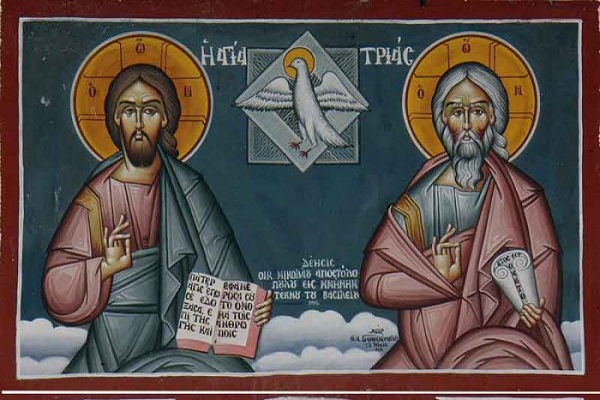“The depiction of the three persons of the Holy Trinity”
14 May 2019The subject of the iconic approach of the Holy Trinity has especially preoccupied me here. And specifically the question whether, religiously wise, the depiction of the Holy Spirit in the classic icon of the Holy Trinity (in the past 350 years), as a pigeon, is correct or at least not harmful, that is the symbolic depiction of the non-built actions of HIM (as in the icon of Baptism) and not, of course, the existential depiction of the Embodied Son. (Besides from the non-built actions of HIM The Father as THE OLD OF DAYS is portrayed in the vision of DANIEL. Also the question arises, whether it is more correct the labeling of the Byzantine Icon of the three angels as “the hospitality of Abraham’’ rather than as “THE HOLY TRINITY”, again from an ecclesiastical point of view given that we have not declined that the holy icons remain the books of the illiterate or perhaps of the half educated brothers of ours. “Daniel is initiated in the unique ownership, having seen Christ heading towards Father and the Spirit indicating the vision (from Triadic Canon of Sunday’s Midnight sound an indirect).
A) THE HOLY ICON OF THE HOLY TRINITY
The dominant opinion among “theological” circles and the majority of hagiographists is that the unruled Father does not appear in the Old Testament and he is totally absent. This right, they claime, is something which only the Son possesses and it is HE who converses with the prophets of the Old Testament. To prove what they claim they use certain hymns of the monthlies from celebrations of prophets and some views of saints spread within the THE GREEK FATHERLY RELIGIOUS TRADITION.

Initially the whole issue, that is, which of the three or the three of the persons of the Holy Trinity altogether appeared in the Old Testament did not preoccupy the Holy Apostles, who lived beside Christ, so as to enact a rule on this.
The same also occurred with the Ecumenical Synods. But in the first two of them, which composed the Symbol of Creed, it is shown that all the persons of the Holy Trinity make themselves felt in the Old Testament.
In the first article of the CREED it says about the ungoverned FATHER and it presents him in the middle of the GENESIS of the cosmos as the Creator of all visible and invisible. “I believe in one God ,the Father Almighty Creator of heaven and earth ,and of all things visible and invisible ”and for not anybody to suppose that the Son is inferior to the Father ,the subsequent article of the Creed presents the Son as the co-creator of the whole Cosmos ,precisely as the Father, so as “ the of the one essence and one value” between the two existences and the Holy Trinity to be founded . “And in one Lord, Jesus Christ, the only begotten Son of God, begotten of the father before all ages. Light of light, true God of true God, begotten, not created, of one essence with the Father, through whom all things were made”.
Subsequently the Creed states the presence of the one essence and one value Holy Spirit.
“In the Holy Spirit, the Lord, the Giver of Life, who proceeds from the Father, who together with the Father and the Son is worshipped and glorified, who spoke through the prophets”.
So if the Highly Holy Spirit is that which converses through the codified, secretive speech with the prophets of the Old Testament, under which logic has the Son the exclusiveness of appearance in the Old Testament and the exclusiveness of conversation with the prophets?
DOES the “we create” man resembling our picture and likeness according to the book of GENESIS not indicate precisely this of the same value participation and cooperation of the Triadic Lord in the creation of Adam?
Does the “Said the Lord to my Lord sit on my right until I put your enemies under your feet” (Psalm 109) not portray concurrently the Father and the Son and not found the of the same value between them as all the Holy commentators of this psalm of David interpret?
And how many other Psalms, half indicate the presence of the, without being dictated to, Father, which are explained by remarkable saints and other interpreters of this God inspired book of the Old Testament?
But let us approach the most characteristic appearance of the Father whom Prophet Daniel regards Him as having a human face and on the Throne giving the Son the authority of doomsday.
It is the first and unique time that “the without being dictated to” father has taken a specific form, a fact which leads us to the conclusion that beyond our right given to us by the VII Ecumenical Synod to depict the vision of the Prophets, the Father himself, according to his not interpreted wish, wanted the human kind to have a specific knowledge of his form.
To Daniel himself he could appear in whatever form he wanted.
The desiring man was invested with a prophetic charisma and a high level of saintness, and in whatever way he regarded him, according to the measures of his acceptance, he could see and write everything that the highly Holy Spirit would say “ The said by the Prophets”.






